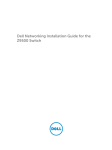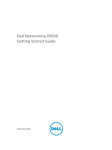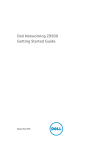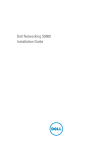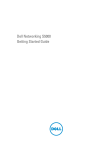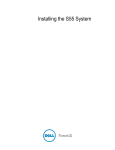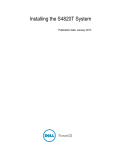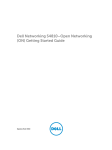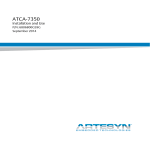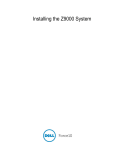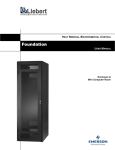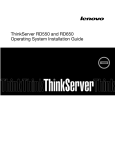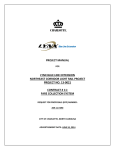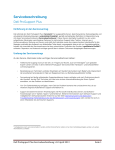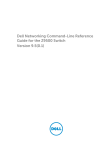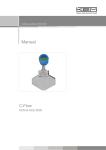Download Dell Networking Z9500 Installation Manual
Transcript
Dell Networking Installation Guide for the Z9500 Switch Notes, Cautions, and Warnings NOTE: A NOTE indicates important information that helps you make better use of your computer. CAUTION: A CAUTION indicates either potential damage to hardware or loss of data and tells you how to avoid the problem. WARNING: A WARNING indicates a potential for property damage, personal injury, or death. Copyright © 2014 Dell Inc. All rights reserved. This product is protected by U.S. and international copyright and intellectual property laws. Dell™ and the Dell logo are trademarks of Dell Inc. in the United States and/or other jurisdictions. All other marks and names mentioned herein may be trademarks of their respective companies. 2014–07 Rev. A02 Contents 1 About this Guide....................................................................................................5 Related Publications.............................................................................................................................. 5 2 Introduction...........................................................................................................6 Product Description.............................................................................................................................. 6 3 Unpacking the Switch.......................................................................................... 7 Hardware Installation Overview............................................................................................................ 7 4 Hardware Overview..............................................................................................9 I/O Panel................................................................................................................................................ 9 Utility Panel.......................................................................................................................................... 10 Power Supplies.............................................................................................................................. 10 Fans................................................................................................................................................ 10 System Status.......................................................................................................................................10 5 Site Preparation...................................................................................................14 Site Selection....................................................................................................................................... 14 Cabinet Placement.............................................................................................................................. 14 Storing Components........................................................................................................................... 15 6 Z9500 Installation...............................................................................................16 Assemble 4–Post Rack Frame............................................................................................................ 16 Attaching the Mounting Brackets....................................................................................................... 16 Attaching the Static-Rails Mounting Brackets.............................................................................. 16 Installing the Dell Static Rails System..................................................................................................17 Identifying the Rail Kit ContentsInstalling and Removing Tool-less Rails (SquareHole)Installing and Removing Tooled Rails (Threaded-Hole Racks or Round-Hole Racks)...... 17 Mounting the Chassis in a Four-Post Rack........................................................................................20 Securing the Chassis Ground............................................................................................................. 24 Installing Fan Modules.........................................................................................................................25 Installing AC Power Supplies.............................................................................................................. 26 Securing Power Cables.......................................................................................................................28 Installing the Cable Management System (OPTIONAL).................................................................... 29 Installing the Cable Management System for Direct Attach Copper (DAC) Cables................... 29 Installing the Cable Management System for Optical Fibres.......................................................31 Installing the QSFP+ Optics................................................................................................................32 Port Numbering Convention.............................................................................................................. 33 Splitting QSFP+ Ports to SFP+ Ports.................................................................................................. 33 Important Points to Remember....................................................................................................34 Supplying Power and Powering Up the System................................................................................ 34 AC Power.......................................................................................................................................34 7 Technical Specifications....................................................................................35 8 Agency Compliance........................................................................................... 36 USA Federal Communications Commission (FCC) Statement......................................................... 36 Canadian Department of Communication Statement...................................................................... 36 European Union EMC Directive Conformance Statement............................................................... 36 European Community Contact.....................................................................................................37 Japan: VCCI Compliance for Class A Equipment.............................................................................. 37 Korean Certification of Compliance.................................................................................................. 38 Safety Standards and Compliance Agency Certifications................................................................. 38 Electromagnetic Compatibility (EMC)................................................................................................38 Product Recycling and Disposal.........................................................................................................39 9 Technical Support.............................................................................................. 40 The iSupport Website......................................................................................................................... 40 Accessing iSupport Services...............................................................................................................40 Requesting a Hardware Replacement............................................................................................... 40 Contacting Technical Support............................................................................................................41 About this Guide 1 This guide provides site preparation recommendations, and step-by-step procedures for rack mounting, installing modules, and connecting to a power source. After you have completed the hardware installation and power-up of the Z9500, for software configuration information, refer to the Dell Networking Configuration Guide for the Z9500 Switch and for Command Line Interface (CLI) information, refer to the Dell Networking Command Line Reference Guide for the Z9500 Switch. CAUTION: To avoid electrostatic discharge (ESD) damage, wear grounding wrist straps when handling this equipment. WARNING: Only trained and qualified personnel can install this equipment. Read this guide before you install and power up this equipment. This equipment contains two power cords. Disconnect both power cords before servicing. WARNING: This equipment contains optical transceivers, which comply with the limits of Class 1 laser radiation. WARNING: When no cable is connected, visible and invisible laser radiation may be emitted from the aperture of the optical transceiver ports. Avoid exposure to laser radiation and do not stare into open apertures. Related Publications For more information about the Z9500, refer to the following documents: • Dell Networking Configuration Guide for the Z9500 Switch • Dell Networking Command Line Reference Guide for the Z9500 Switch • Dell Networking Release Notes for the Z9500 Switch NOTE: For the most recent documentation and software, visit iSupport (registration for access to some sections is required): http://www.dell.com/support/manuals. About this Guide 5 2 Introduction This document provides basic information about installing the Z9500 switch. For information about how to configure and monitor switch features, refer to the Dell Networking Configuration Guide for the Z9500 Switch, which is available on the Dell Support website at http:// support.dell.com/manuals. This document contains the following sections: • Product Description • Unpacking the Switch • Hardware Overview • Site Preparations • Z9500 Installation • Technical Specifications • Agency Compliance • Technical Support Product Description The Z9500 is part of Dell Networking's Z-Series family of Data Center Core switches. The Z9500 switch is a compact 3 RU (Rack Unit), high-performance, and low-latency 10/40–Gigabit Ethernet switch. It runs the Dell Networking Operating Software (OS) , providing features and capabilities that are widely deployed. The Z9500 switch has the following features: • 132 fixed Quad Small Form-Factor Pluggable (QSFP+) ports on the I/O side of the switch. • Four slots on the Utility side of the switch for hot swappable power supplies. • Five slots on the Utility side of the switch for hot swappable fan modules. • A management and console interface on the I/O side of the switch. 6 Introduction Unpacking the Switch 3 The switch and its accessories are shipped in a single box. The power cords may be shipped in a separate box. Before unpacking the switch, inspect the container and immediately report any evidence of damage. Verify that you have received your ordered items, including the following: WARNING: If any item is missing or damaged, contact your Dell Networking representative or reseller for instructions. CAUTION: Always wear an ESD-preventive wrist or heel ground strap when handling the switch and its components. Ground yourself by using an antistatic wrist strap or other device and connect it to the ESD grounding jack on the chassis. As with all electrical devices of this type, take all necessary safety precautions to prevent injury when installing this system. CAUTION: The system is packaged in one or two separate containers. Use an equipment lift or pallet jack to lift or install the chassis. Lifting the system by its shelves will cause damage to the chassis • Z9500 switch • Static-Rail kit (#1 and #2 Phillips and flat-tipped screwdrivers required) NOTE: One Rail Kit is required for every chassis in a rack. • Screws for rack installation • Console cables • Any optional items ordered • Getting Started Guide • Safety and Regulatory Information • Warranty and Support Information • Software License Agreement 1. Place the container on a clean, flat surface and cut all straps securing the container. 2. Open the container or remove the container top. 3. Carefully remove all components from the container and place it on a secure and clean surface. 4. Remove all packing material. 5. Inspect the switch and accessories for damage. Hardware Installation Overview To install the Z9500, follow these steps: 1. Assemble 4-Post Rack Frame 2. Attaching the Mounting Brackets 3. Installing the Dell Static Rails System 4. Securing the Chassis Ground 5. Installing AC Power Supplies Unpacking the Switch 7 6. Installing Fan Modules 7. Securing Power Cables 8. Installing the QSFP+ Optics 9. Installing the Cable Management System 10. Supplying Power and Powering Up the System 8 Unpacking the Switch Hardware Overview 4 This section contains information about device characteristics and modular hardware configurations for the Z9500. The Z9500 has the following physical dimensions: • Height: 5.2 inches (132.08 mm) • Width: 17.4 inches (441.96 mm) • Depth: 32 inches (812.80 mm) The Z9500 has a chassis design with 5280Gbps switching bandwidth. The system also provides one DB9 RS-232 console port with YOST RJ-45 pinout and a dedicated Ethernet service port for out-of-band (OOB) management functions. I/O Panel All fixed data ports (132 × 40GbE quad small form-factor pluggable plus [QSFP+] ports) are on the I/O panel. Figure 1. I/O Panel The I/O panel includes: • 132 fixed Quad Small Form-Factor Pluggable (QSFP+) ports • Light Emitting Diodes (LEDs) • Management ports NOTE: The LED displays for the system status are on the I/O side of the chassis. The fan and power status LEDs are on the Utility panel. Hardware Overview 9 Utility Panel The Utility panel side of the platform contains the fan and power modules. Figure 2. Utility Side 1. Fan Trays 2. Power Supplies Power Supplies The Z9500 supports four hot-swappable Power supply units (PSUs) . NOTE: The PSUs must be installed at the customer site. PSUs are field replaceable. To ensure power redundancy and adequate cooling, install four power supplies in the switch. When running with full redundancy (four PSUs installed and running), you can remove and replace a PSU while the other PSUs are running without disrupting traffic. Fans The Z9500 supports five fan trays with airflow directions from I/O to Utility. The fans must be installed at the customer site. System Status You can view Z9500 status information in several ways, including: • LEDs • CLI show commands • Simple network management protocol (SNMP) For more information about these options, refer to the Dell Networking Command Line Reference Guide and Dell Networking Configuration Guide for the Z9500 Switch. As shown in the following figure, the Z9500 includes LED displays on the I/O and Utility side of the chassis. When the Z9500 powers up or reloads, the status LED on the power supplies are solid green. 10 Hardware Overview The following table lists the LED definitions for the Z9500 system. Figure 3. System LED Displays (I/O Panel) 1. Alarm LED 2. System status LED 3. System locator LED 4. 10GbE channel selection indicator 5. 10GbE channel selector button 6. Management Port Activity LED 7. Management Port Status LED Table 1. System LED Displays (I/O Panel) Label LED Color/ Display Description Alarm LED • • • Off Amber solid Red solid • • • No alarm Minor alarm Major alarm System status LED • • • Off Green solid Green blinking • • • No power Normal operation System is booting System locator LED • • Off Blue solid • • No activity Port locator • • Off Green blinking • • No activity The port and the link are active, and there is link activity Management port activity LED Hardware Overview 11 Label LED Color/ Display Description Management port status LED • • • • Off Green solid Port is Down Traffic on Management Port Figure 4. 40GbE Port LEDs (I/O Panel) 1. Port LED NOTE: In 40GbE mode, the front end ports are “solid green” color in operational state. However, if the port is configured to work in 10GbE mode, then the front end ports are “solid amber” color in operational state. NOTE: The four 10GbE ports split from a single 40GbE port share the same locator LED as the 40GbE port. Use the CLI system location-led interface fortyGigE /tengigabitethernet SLOT/PORT on command to locate the 10GbE/40GbE port and then press the channel selector button to locate the corresponding 10GbE port as shown in Figure 3. When port locator functionality is enabled on a port - the corresponding port LED turns solid blue. Table 2. 40GbE Port LEDs Label LED Color/Display Description Port locator LED • • Off Blue • • No activity Port locator Port link/activity LED • • • • • Off Green solid Green blinking Amber solid Amber blinking • • • • • No link or interface disabled 40GbE link present and interface enabled Port has activity 10GbE link present and interface enabled 10GbE port has activity 12 Hardware Overview Figure 5. System LED Displays (Utility Panel) 1. Fan status LED 2. PSU status LED Table 3. System LED Displays (Utility Panel) Label LED Color/Display Description PSU status LED • • • Green solid Amber Solid Off • • • Normal operation Minor/Major alarms Power not present Fan status LED • • • Green solid Amber Solid Off • • • Normal operation Minor/Major alarms Power not present Hardware Overview 13 5 Site Preparation The Z9500 is suitable for installation as part of a Common Bond Network (CBN). It can be installed in: • network telecommunication facilities • data centers • other locations where the National Electric Code (NEC) applies This chapter contains the following sections: • Site Selection • Cabinet Placement • Storing Components Site Selection Dell Networking equipment is intended for installation in restricted access areas. A restricted access area can only be accessed by service personnel by using a special tool, lock, key or other means of security and access is controlled by the authority responsible for the location. Ensure that the area where you install your Z9500 system meets the following safety requirements: • Near an adequate power source. Connect the system to the appropriate branch circuit protection as defined by your local electrical codes. • Environmental temperature between 32° to 104°F (0° to 40°C). • Humidity that does not exceed 85 percent noncondensing. • In a dry, clean, well-ventilated and temperature-controlled room, away from heat sources such as hot air vents or direct sunlight. • Away from sources of severe electromagnetic noise. • Positioned in a rack or cabinet, or on a desktop with adequate space in the front, rear, and sides of the Z9500 for proper ventilation and access. Cabinet Placement Install the Z9500 only in indoor cabinets designed for use in a controlled environment as described in Site Selection. The cabinet must meet the following criteria: • 14 Minimum cabinet size and airflow are according to the Electronic Industries Alliance (EIA) standard. Site Preparation Storing Components If you do not install your Z9500 and components immediately, Dell Networking recommends properly storing the system and all optional components until you are ready to install them. WARNING: ESD damage can occur when components are mishandled. Always wear an ESDpreventive wrist or heel ground strap when handling the Z9500 and its accessories. After you remove the original packaging, place the Z9500 and its components on an anti-static surface. 1. Storage temperature must remain constant ranging from -4° to 158° F (-20°C to 70° C). 2. Store on a dry surface or floor, away from direct sunlight, heat, and air conditioning ducts. 3. Store in a dust-free environment. Site Preparation 15 6 Z9500 Installation To install the Z9500, follow these steps: 1. Assemble 4-Post Rack Frame 2. Attaching the Mounting Brackets 3. Installing the Dell Static Rails System 4. Securing the Chassis Ground 5. Installing Fan Modules 6. Installing AC Power Supplies 7. Securing Power Cables 8. Installing the Cable Management System 9. Installing the QSFP+ Optics 10. Supplying Power and Powering Up the System Assemble 4–Post Rack Frame Due to chassis weight, the Z9500 switch does not support installation in a 2-post rack; you must install the Z9500 in a 4-post rack. To install a 4-post rack frame, follow the instructions in your rack frame kit. In a 4-post rack, the maximum supported distance between the front and back vertical posts is 36 inches; the minimum supported distance is 24 inches. Attaching the Mounting Brackets The switch is shipped with static rails mounting brackets (rack ears) and the required screws for rack or cabinet installation. The brackets are enclosed in a package with the chassis. Attaching the Static-Rails Mounting Brackets 1. Take the static-rail mounting brackets and screws out of their packaging. 2. Attach the brackets to the I/O side of the chassis, using eight screws for each bracket. Attach each bracket so that the “ear” faces the I/O side with the black thumb screw at the bottom of the “ear” (as shown in the following illustration). 16 Z9500 Installation 1. Utility side of the chassis 3. Static-rail mounting bracket 2. Screws Installing the Dell Static Rails System Dell Networking provides the Static Rails rack mounting system so you can easily configure a rack to install the switch. Identifying the Rail Kit Contents Locate the components for installing the rail kit assembly: • Two Dell Static Rails assemblies (1) (2). NOTE: Supports rack length between 24 and 36 inches. Z9500 Installation 17 Installing and Removing Tool-less Rails (Square-Hole) 1. Position the left and right rail end pieces FRONT facing inward and orient each end piece to seat in the holes on the front side of the vertical rack flanges (1). 2. Align each end piece in the bottom and top holes of the desired U spaces (2). 3. Engage the back end of the rail until it fully seats on the vertical rack flange and the latch clicks into place. Repeat these steps to position and seat the front end piece on the vertical flange. NOTE: Make sure the blue release latch is closed. 4. 18 To remove the rails, pull on the blue release latch on each end piece and unseat the rail from the rack. Z9500 Installation Installing and Removing Tooled Rails (Threaded-Hole Racks or Round-Hole Racks) 1. Remove the pins from the front and rear mounting brackets using a flat-tipped screwdriver (2). 2. Pull on the rail latch subassemblies to remove them from the mounting brackets (1). 3. Attach the left and right mounting rails to the front vertical rack flanges using two pairs of screws. 4. Slide the left and right rear brackets forward against the rear vertical rack flanges and attach them using two pairs of screws (3). Z9500 Installation 19 Mounting the Chassis in a Four-Post Rack Safety Considerations for Rack Mounting WARNING: You must use a lifting device, such as a fork-lift trolley, to lift the chassis. The following guidelines are general safety considerations. For detailed information, read the safety instructions in your Safety, Environmental, and Regulatory information booklet before you begin. • • 20 Rack loading — Overloading or uneven loading of racks may result in shelf or rack failure, which may damage equipment and cause possible personal injury. Stabilize racks in a permanent location before loading begins. Mount the components beginning at the bottom of the rack, then work to the top. Do not exceed your rack load rating. Power considerations — Connect only to the power source specified on the unit. When multiple electrical components are installed in a rack, ensure that the total component power ratings do not exceed the circuit capabilities. Overloaded power sources and extension cords present fire and shock hazards. Z9500 Installation • • • • • Elevated ambient temperature — If installed in a closed rack assembly, the operating temperature of the rack environment may be greater than the room ambient temperature. Use care not to exceed the 40°C maximum ambient temperature of the switch. Reduced air flow — Install the equipment in the rack so that the amount of airflow required for safe operation of the equipment is not compromised. Reverse air flow — Necessary clearance is required to ensure cool air intake and to avoid hot air blow out from I/O panel. Reliable earthing — Maintain reliable earthing of rack-mounted equipment. Pay particular attention to the supply connections other than the direct connections to the branch circuit; for example, use of power strips. Do not mount the equipment with the Utility panel facing in the downward position. NOTE: The illustrations in this document are not intended to represent a specific switch. Installing the Switch in a 1200 mm Rack Enclosure To install the Z9500 in a rack enclosure which must have front and back doors closed and provide enough space for cables (I/O and power supply), you must use an extended rack that is at least 1200 mm in depth. To install the Z9500 in a 1200 mm rack enclosure: 1. Re-position and fasten the front rack posts (vertical rails) 6 inches back towards the rear of the rack. 2. Verify that the position of the rear vertical rails within the rack line up for the mount distance (from the front vertical rails) as you snap the mounting rails into place. If the rear vertical rails require adjustment, adjust as necessary. 3. Lift the chassis, align it with the rails installed in the rack, and slide the chassis into the rack. The front I/O panel of the chassis should be flush with the front vertical rails and sit 6 inches back from the front door. There should be sufficient space to attach QSFP+ optics and cables to the front I/O panel. There should also be adequate room to attach power supply cables at the rear of the chassis. 4. Tighten the screws on each side of the front panel. Installing the Switch in a 1070 mm Rack Enclosure This section describes your options to install the Z9500 switch in a 1070 mm rack enclosure. Due to chassis depth, the Z9500 switch does not support installation in a 1070 mm cabinet with front and back doors closed. If your Z9500 installation requires both front and back doors to be closed, use a rack enclosure with extended length. When you install the Z9500 switch in a 1070 mm rack enclosure with a front and back door, you must either leave the front door open or remove it. (This is the typical Z9500 installation scenario. If you must close the front door, refer to procedure for installing the switch in a rack enclosure with no back door later in this section.) To install the Z9500 in a 1070 mm rack enclosure with no front door: 1. Lift the chassis, align it with the rails installed in the rack, and slide the chassis into the rack. The front I/O panel of the chassis should be flush with the rack opening and provide adequate space on the PSU side of the chassis to attach power cords (see the following figure). 2. Tighten the screws on each side of the front panel. To remove the chassis from the rack, loosen the screws and slide the chassis out of the rack. Z9500 Installation 21 Installing the Z9500 in a Rack Enclosure with No Front Door 1. Top view of rack enclosure (for example, Dell 4226 – 1070 mm cabinet) 2. Front door has been removed. When you install the Z9500 switch in a 1070 mm rack enclosure in which the front door must be closed, either leave the back door open or remove the back door. Then follow these steps. 1. Re-position and fasten the front rack posts (vertical rails) 6 inches back towards the rear of the rack (as shown in the next figure). 2. Lift the chassis, align it with the rails installed in the rack, and slide the chassis into the rack. The front I/O panel of the chassis should be flush with the front vertical rails and sit 6 inches back from the front door. There should be sufficient space to attach QSFP+ optics and cables to the front I/O panel. 22 Z9500 Installation 3. Tighten the screws on each side of the front panel. NOTE: If your 1070 mm rack enclosure uses vertical power distribution units (PDUs) that occupy the space required by the Z9500 when it is installed 6 inches from the front door, do one of the following: • Replace the vertical PDUs with shorter or horizontal PDUs. • Use an extended-length (1200 mm) rack. Installing the Z9500 in a Rack Enclosure with No Back Door 1. Top view of rack enclosure (for example, Dell 4226 – 1070 mm cabinet) 2. Adjustable front vertical rails 3. 6 inches behind front door 4. Back door has been removed. Z9500 Installation 23 1. Additional screw to restrict front-back movement of the switch 2. Main screw Securing the Chassis Ground After you mount the chassis, secure the chassis ground as follows: 1. 24 Locate the chassis ground connector nuts on the chassis rear. Z9500 Installation 2. Install the grounding cables to the ground nuts. The grounding cable must comply with your local electrical codes in size and color (typically the color is green or green with yellow stripe). NOTE: For proper ventilation, position the chassis in an equipment rack (or cabinet) with a minimum of 5 inches (12.7 cm) of clearance around exhaust vents. The acceptable ambient temperature ranges are listed in the Environmental Parameters section. Use M5 screws. 3. Tighten the screws (torque should be between 18 and 24 inch/lbs). 4. Connect the opposite end of the grounding cable to the nearest appropriate facility grounding post. Figure 6. Cable Connector Installing Fan Modules The chassis requires five fan modules to be installed for normal configuration. The airflow direction must be from I/O to Utility. Important Points to Remember for Installing a Fan Module • The Utility panel consists of five slots numbered from 0 to 4. Insert the fan modules in slots 0, 1, 2, 3, and 4. Module slot 0 is on the left side of the chassis; module slot 4 is on the right side of the chassis. • Fan modules are hot-swappable. If you remove a fan module during normal Z9500 operation, you must insert a new fan module within three minutes. • If a fan module fails, the system during normal operation continues to operate without a significant degradation in cooling capacity for a TBD duration. Z9500 Installation 25 • The cooling system is designed such that, during normal operation, the fans typically run at somewhere between 40 and 50 percent of their maximum speed at 26°C ambient temperature. This feature results in lower noise and higher average fan life. The switch increases the fan speed to maximum if the facility air condition fails or if a fan fails. • The fan speed increases and decreases automatically based on the internal temperature. The switch never intentionally turns off the fans. • For proper ventilation, position the switch in an equipment rack (or cabinet) with a minimum of 5 inches (12.7 cm) of clearance around the exhaust vents. When you install two systems near each other, position the two chassis at least 5 inches (12.7 cm) apart to permit proper airflow. The acceptable ambient temperature ranges are listed in Technical Specifications. • To view the log messages, use the show logging command. For more information, refer to the System Logs chapters of the Dell Networking OS Command Line Reference Guide for the Z9500 Switch and Dell Networking OS Configuration Guide for the Z9500 Switch. 1. Take the fan module out of the shipping box. 2. Use the grab handle to slide the fan module into the switch fan slot, as shown below. Figure 7. Installing a Fan Module 1. Release latch 2. Fan module 0/Slot 0 Installing AC Power Supplies The chassis requires four power supplies to be installed for normal configuration. The airflow direction must be from I/O to Utility. Important Points to Remember for Installing an AC Power Supply • The power supply unit (PSU) slides into the slot smoothly. Do not force a PSU into a slot as this action may damage the PSU or the chassis. • The chassis supports AC power supplies with air-flow direction from I/O to Utility. 26 Z9500 Installation • For PSUs, a LED indicates the power status. • To view the log messages, use the show logging command. For more information, refer to the System Logs chapters of the Dell Networking OS Command Line Reference Guide for the Z9500 Switch and Dell Networking OS Configuration Guide for the Z9500 Switch. WARNING: Although the switch can run on two PSUs, Dell Networking requires using four PSUs for full redundancy and proper cooling. WARNING: The Utility panel consists of four slots numbered from 0 to 3. Insert PSUs in slots 0, 1, 2, and 3. WARNING: The PSU edge connector is at the bottom. Avoid installing the PSU upside down. WARNING: Electrostatic discharge (ESD) damage can occur if components are mishandled. Ground yourself by using an antistatic wrist strap or other device and connect it to the ESD grounding jack on the chassis. 1. Remove the PSU from the electro-static bag. 2. Use the grab handle to slide the PSU into the switch PSU slot. The PSU slot is keyed so that the PSU can be fully inserted in only one way. When you install the PSU correctly, it snaps into place and is flush with the back of the switch. Figure 8. Installing an AC Power Supply 1. Release latch 2. Slot 0 (for AC PSU 0) CAUTION: Fan tray modules must be inserted before powering up the switch. CAUTION: The switch has a high line-voltage requirement of minimum 200V. 3. Plug in the AC3 prong cord from the switch PSU to the external power source (the AC wall outlet). Z9500 Installation 27 Figure 9. Connecting AC Power Supply Cords 1. AC3 Prong NOTE: The system is powered-up as soon as you connect the power cord between the system and the power source. CAUTION: Always disconnect the power cable before you service the power supply slots. CAUTION: Use the power supply cord as the main disconnect device on the AC system. Ensure that the socket-outlet is located/installed near the equipment and is easily accessible. 4. Repeat steps 1 through 3 above for all PSUs. NOTE: Ensure that the PSU is correctly installed. When you correctly install the PSU, the power connector is on the left side of the PSU. Securing Power Cables 1. Bend the system power cables, as shown in the following illustration, and attach to the cable clasp. NOTE: Install all four PSUs before securing the power cables. 28 Z9500 Installation Figure 10. Securing Power Cables 1. 2. Velcro strap 2. Power Cable Plug the other end of the power cables into a grounded electrical outlet or a separate power source such as an uninterruptible power supply (UPS) or a power distribution unit (PDU). CAUTION: The switch has a high line-voltage requirement of minimum 200V. NOTE: For better performance, ensure that the system is connected to a stand-alone power source with stable power supply. Installing the Cable Management System (OPTIONAL) You must order the cable management mount assembly separately. Mount the assembly on the top front of the chassis to organize network cables and to minimize obstruction from these cables while you insert, remove, and view the chassis components. Using the cable management system, you can attach the maximum number of cables in Z9500 I/O ports. NOTE: The installation of the cable management system requires that you install these parts in the order presented in this document. It is recommended that you install the cable management system after the chassis is installed into the rack or cabinet. WARNING: When you cable the ports, be sure not to interfere with the airflow from the small vent holes above and below the ports. Installing the Cable Management System for Direct Attach Copper (DAC) Cables 1. Secure the cable management system into place on the 4–post rack frame above the I/O side of the chassis by inserting screws and tightening with a #2 Phillips screwdriver. Z9500 Installation 29 Figure 11. Installing the Cable Management System for DAC Cables 1. 2. 30 Pin rack unit for DAC cable routing 2. Rack unit for DAC cable routing Insert a cable in a Z9500 port. then route the DAC cables up and along the line-card face between the larger pins directly above the card. Position the cables so they follow the channel marked in the figure below and exit to the right or left, depending on the chassis slot location. The cables should emerge from right and left side of the panel. Z9500 Installation Figure 12. Routing DAC cables using the Cable Management System 1. Pin rack unit for DAC cable routing 2. Rack unit for DAC cable routing NOTE: To fully populate the cable management system in a 1070 mm cabinet, the maximum supported length of the DAC cable is 5 m. Installing the Cable Management System for Optical Fibres Insert an optical cable in a Z9500 port. then route the optical cable up and along the line-card face above the switch. Position the cables so they follow the channel marked in the figure below and exit to the right or left, depending on the chassis slot location. The cables should emerge from right and left side of the panel. Z9500 Installation 31 Figure 13. Routing Optical Fibres using the Cable Management System 1. Rack unit to be installed only for optical cables 2. Z9500 switch NOTE: When the switch operates in the supported temperature range, LR4 optics can be used only in the upper half of the ports on the switch: • Line card 0 — only in ports 12, 16, 20, 36, 40, 44, 60, 64, 68, 84, 88, 92, 108, 112, 116, 132, 136, and 140. • Line card 1 — only in ports 12, 16, 20, 36, 40, 44, 60, 64, 68, 84, 88, 92, 108, 112, 116, 132, 136, 140, 156, 160, 164, 180, 184, and 188. • Line card 2 — only in ports 12, 16, 20, 36, 40, 44, 60, 64, 68, 84, 88, 92, 108, 112, 116, 132, 136, 140, 156, 160, 164, 180, 184, and 188. When the switch operates in a reduced ambient temperature, you can use LR4 optics in any port. See Port Numbering Convention for an illustration that shows port location. Installing the QSFP+ Optics The switch has 132 QSFP+ optical ports, which can be used with breakout cables for 528 small formfactor pluggable plus (SFP+) optical ports. When the switch operates in the supported temperature range, LR4 optics can be used only in the upper half of the ports on the switch: • On line card 0: only in ports 12, 16, 20, 36, 40, 44, 60, 64, 68, 84, 88, 92, 108, 112, 116, 132, 136, and 140. • On line card 1: only in ports 12, 16, 20, 36, 40, 44, 60, 64, 68, 84, 88, 92, 108, 112, 116, 132, 136, 140, 156, 160, 164, 180, 184, and 188. • On line card 2: only in ports 12, 16, 20, 36, 40, 44, 60, 64, 68, 84, 88, 92, 108, 112, 116, 132, 136, 140, 156, 160, 164, 180, 184, and 188. 32 Z9500 Installation Refer to the Port Numbering Convention illustration in the Dell Networking Z9500 Getting Started Guide for exact port location. For a list of supported optics, contact your Dell Networking representative or reseller. CAUTION: ESD damage can occur if the components are mishandled. Always wear an ESDpreventive wrist or heel ground strap when handling the switch and its components. WARNING: When working with optical fibres, follow all the warning labels and always wear eye protection. Never look directly into the end of a terminated or unterminated fibre or connector as it may cause eye damage. 1. Position the optic so it is in the correct position. The optic has a key that prevents it from being inserted incorrectly. 2. Insert the optic into the port until it gently snaps into place. Port Numbering Convention On the switch, all ports operate by default in 40GbE mode. If you use a breakout cable, each port can operate in 4x10GbE mode. Ports are located on three line cards as shown below. The line cards are factory-installed and are not hot-swappable or field-replaceable. On each line card, the fixed 40GbE ports are numbered from bottom to top in multiples of four, starting with zero; for example, 0, 4, 8, 12, and so on. When a breakout cable is installed, the resulting four 10GbE ports are numbered with the remaining numbers. For example, 40GbE port 0 contains 10GbE ports 0, 1, 2, and 3; 40GbE port 4 contains 10GbE ports 4, 5, 6, and 7. Line card 0 consists of ports 0 to 143; line card 1 consists of ports 0 to 191; line card 2 consists of ports 0 to 191. Figure 14. Port Numbering Splitting QSFP+ Ports to SFP+ Ports The system supports splitting a single 40GbE QSFP+ port into four 10GbE SFP+ ports using one of the supported breakout cables. For a list of supported optics, contact your Dell Networking representative or reseller. • Configure the system to recognize the port mode change. Z9500 Installation 33 CONFIGURATION mode linecard number port number portmode quad – port <number>- Enter the port number of the 40GbE port to be split. The range is 48 to 60. – portmode quad - Configure a 40GbE port to operate in 4 x 10GbE mode. Example of splitting a QSFP+ port to SFP+ ports linecard 0 port 52 portmode quad Important Points to Remember • A 40GbE (quad) port must be in a default configuration before you can split it into four 10GbE SFP+ ports. When you split the port, the 40GbE port is lost in the running configuration. Be sure that the port is also removed from other L2/L3 feature configurations. • For the split-port change to take effect, you must reload the system after issuing the CLI change commands. Supplying Power and Powering Up the System Supply power to the system after the chassis is mounted in a rack or cabinet. CAUTION: The switch has a high line-voltage requirement of minimum 200V. Dell Networking recommends reinspecting your system prior to powering up. Verify that: • The equipment is properly secured to the rack. • The equipment rack is properly mounted and grounded. • The ambient temperature around the unit (which may be higher than the room temperature) is within the limits specified for the switch. • There is sufficient airflow around the chassis. • The input circuits are correctly sized for the loads and that you use sufficient overcurrent protection devices. NOTE: For powering up the AC PSUs, AC power cables are included in the shipping container. You must order all other power cables separately. CAUTION: ESD damage can occur if the components are mishandled. Always wear an ESDpreventive wrist or heel ground strap when handling the switch and its components. When the system powers up, the fans come on at medium speed. The fan speed slows as the system boots up. The system status LED blinks until the boot-up sequence is complete. When the boot up is complete, the power status LED is steadily lit. AC Power CAUTION: Ensure that the PSU is installed correctly. Connect the plug to each AC power connector. Make sure that the power cord is secure. As soon as the cable is connected between the switch and the power source, the chassis is powered-up; there is no on/off switch. 34 Z9500 Installation Technical Specifications 7 NOTE: Operate the product at an ambient temperature not higher than 40°C. Table 4. Chassis Physical Design Parameter Specifications Height 5.2 inches (132.08 mm) Width 17.4 inches (441.96 mm) Depth 32 inches (812.80 mm) Chassis weight with factory-installed components 122 pounds (Approximately) Rack clearance required • • Front: 5 inches (12.7 cm) Rear: 5 inches (12.7 cm) Table 5. Environmental Parameters Parameter Specifications Operating temperature 32° to 104°F (0° to 40°C) Operating humidity 10 to 85 percent (RH), noncondensing Storage temperature -40° to 158°F (-40° to 70°C) Storage humidity 5 to 95 percent (RH), noncondensing Maximum thermal output 10567 BTU/hr Maximum Altitude No performance degradation up to 6600ft. Ambience derating required for higher altitude. Table 6. Power Requirements Parameter Specifications AC Power supply 200 VAC ~ 240 VAC 50/60 Hz Maximum AC current per supply 10A Maximum power consumption 3100 Watts Typical power consumption 2200 Watts Technical Specifications 35 8 Agency Compliance USA Federal Communications Commission (FCC) Statement This equipment has been tested and found to comply with the limits for a Class A digital device, under Part 15 of the FCC rules. These limits are designated to provide reasonable protection against harmful interference when the equipment is operated in a commercial environment. This equipment generates, uses, and can radiate radio frequency energy. If it is not installed and used in accordance to the instructions, it may cause harmful interference to radio communications. Operation of this equipment in a residential area is likely to cause harmful interference, in which case users will be required to take whatever measures necessary to correct the interference at their own expense. Properly shielded and grounded cables and connectors must be used in order to meet FCC emission limits. Dell Networking is not responsible for any radio or television interference caused by using other than recommended cables and connectors or by unauthorized changes or modifications in the equipment. Unauthorized changes or modification could void the user’s authority to operate the equipment. This device complies with Part 15 of the FCC Rules. Operation is subject to the following two conditions: • This device may not cause harmful interference • This device must accept any interference received, including interference that may cause undesired operation Canadian Department of Communication Statement European Union EMC Directive Conformance Statement This product is in conformity with the protection requirements of EU Council Directive 2004/108/EC on the approximation of the laws of the Member States relating to electromagnetic compatibility. Dell Networking cannot accept responsibility for any failure to satisfy the protection requirements resulting from a nonrecommended modification of this product, including the fitting of non-Dell option cards. This product has been tested and found to comply with the limits for Class A Information Technology Equipment according to CISPR 22/European Standard EN 55022. The limits for Class A equipment were 36 Agency Compliance derived for commercial and industrial environments to provide reasonable protection against interference with licensed communication equipment. WARNING: This is a Class A product. In a domestic environment, this device may cause radio interference, in which case, you may be required to take adequate measures. European Community Contact Dell Networking EMEA — Central Dahlienweg 19 66265 Heusweiler Germany http://www.force10networks.com/german/ Japan: VCCI Compliance for Class A Equipment WARNING: Use the AC power cords with Dell Networking equipment only. Do not use Dell Networking AC power cords with any unauthorized hardware. This is Class A product based on the standard of the Voluntary Control Council For Interference by Information Technology Equipment (VCCI). If this equipment is used in a domestic environment, radio disturbance may arise. When such trouble occurs, the user may be required to take corrective actions. Agency Compliance 37 Korean Certification of Compliance Korean Package Label Safety Standards and Compliance Agency Certifications • CUS UL 60950-1, Second Edition • CSA 60950-1-03, Second Edition • EN 60950-1, Second Edition • EN 60825-1, First Edition • EN 60825-1 Safety of Laser Products — Part 1: Equipment Classification Requirements and User’s Guide • EN 60825-2 Safety of Laser Products — Part 2: Safety of Optical Fibre Communication Systems • FDA Regulation 21CFR 1040.10 and 1040.11 • IEC 60950-1, Second Edition, including all National Deviations and Group Differences Electromagnetic Compatibility (EMC) Emissions • International: CISPR 22: 2006, Class A • Australia/New Zealand: AS/NZS CISPR 22:2009, Class A • Canada: ICES-003, Issue-4, Class A • Europe: EN55022 2006 (CISPR 22: 2006), Class A • Japan: VCCI V-3/2011.04 Class A • USA: FCC CFR47 Part 15, Subpart B, Class A Immunity • EN 300 386 v1.5.1:2010 EMC for Network Equipment • EN55022 2006, Class A • EN 55024 1998 + A1: 2001 + A2: 2003 • EN 61000-3-2 Harmonic Current Emissions • EN 61000-3-3 Voltage Fluctuations and Flicker 38 Agency Compliance • EN 61000-4-2 ESD • EN 61000-4-3 Radiated Immunity • EN 61000-4-4 EFT • EN 61000-4-5 Surge • EN 61000-4-6 Low Frequency Conducted Immunity Product Recycling and Disposal You must recycle or discard this system according to applicable local and national regulations. Dell Networking encourages owners of information technology (IT) equipment to responsibly recycle their equipment when it is no longer needed. Dell Networking offers various product return programs and services in several countries to assist equipment owners in recycling their IT products. Waste Electrical and Electronic Equipment (WEEE) Directive for Recovery, Recycle and Reuse of IT and Telecommunications Products Dell Networking switches are labeled in accordance with European Directive 2002/96/EC concerning waste electrical and electronic equipment (WEEE). The Directive determines the framework for the return and recycling of used appliances as applicable throughout the European Union. This label is applied to various products to indicate that the product is not to be thrown away, but rather reclaimed upon end of life per this Directive. Figure 15. The European WEEE symbol In accordance with the European WEEE Directive, electrical and electronic equipment (EEE) is to be collected separately and to be reused, recycled, or recovered at end of life. Users of EEE with the WEEE marking per Annex IV of the WEEE Directive, as shown above, must not dispose of end of life EEE as unsorted municipal waste, but use the collection framework available to customers for the return, Specifications | 47 recycling and recovery of WEEE. Customer participation is important to minimize any potential effects of EEE on the environment and human health due to the potential presence of hazardous substances in EEE. Dell Networking products, which fall within the scope of the WEEE, are labeled with the crossed-out wheelie-bin symbol, as shown above, as required by WEEE. For information on Dell Networking product recycling offerings, see the WEEE Recycling instructions on iSupport at: http://downloads.dell.com/Manuals/all-products/esuprt_electronics/ esuprt_docking_stations/dell-superspeed-usb3-dock-stn_Reference%20Guide_en-us.pdf? c=us&l=en&cs=&s=gen Agency Compliance 39 9 Technical Support This chapter contains the following sections: • The iSupport Website • Accessing iSupport Services • Requesting a Hardware Replacement • Contacting Technical Support The iSupport Website iSupport provides a range of documents and tools to assist you with effectively using Dell Networking equipment and mitigating the impact of network outages. Through iSupport you can obtain technical information regarding Dell Networking products, access to software upgrades and patches, and open and manage your Tech Support cases. Dell Networking iSupport provides integrated, secure access to these services. Accessing iSupport Services The URL for iSupport is http://www.force10networks.com/ CSPortal20/Main/Login.aspx . You must have a userid and password to access iSupport services. 1. On the Dell Networking Support page, click the Account Request link. 2. Fill out the User Account Request form and click Send. You will receive your userid and password by E-mail. 3. To access iSupport services, click the LOGIN link and enter your userid and password. Requesting a Hardware Replacement 1. Determine the part number and serial number of the component. To list the numbers for all components installed in the chassis, use the show inventory command. 2. Request a RMA number from Tech Support by opening a support case. Open a support case by: a. Using the Create Service Request form on the iSupport page (refer to Contacting Technical Support). b. Contacting Dell Networking directly by E-mail or by phone (refer to Contacting Technical Support). Provide the following information when using E-mail or phone: 40 • Part number, description, and serial number of the component. • Your name, organization name, telephone number, fax number, and E-mail address. • Shipping address for the replacement component, including a contact name, phone number, and E-mail address. • A description of the failure, including log messages. This can include: Technical Support – Output from the show tech-support command (This report is very long so set the storage buffer in your terminal program to high.) – Output from the show logging command, on the unit that experienced the failure (This report is included as a section in the output of show tech-support command.) – Console captures showing the error messages. – Console captures showing the troubleshooting steps taken. – Saved messages to a syslog server, if you use one. Contacting Technical Support How to Contact Dell Networking Tech Support Log in to iSupport at http:// www.force10networks.com/CSPortal20/Main/ Login.aspx and select the Service Request tab. Information to Submit When Opening a Support Case • Your name, company name, phone number, and E-mail address • Preferred method of contact • Model number • Software version number • Symptom description • Screen shots showing the symptom, including any error messages. This can include: • Output from the show tech-support command (This report is very long so set the storage buffer in your terminal program to high.) • Output from the show logging command, on the unit that experienced the failure (This report is included as a section in the output of the show tech-support command.) • Console captures showing the error messages • Console captures showing the troubleshooting steps taken • Saved messages to a syslog server, if you use one Managing Your Case Log in to iSupport and select the Service Requestt tab to view all open cases and Return Materials Authorizations (RMAs). Downloading Software Updates Log in to iSupport and select the Software Center tab. Technical Documentation Log in to iSupport and select the Documents tab. You can access this page without logging in using the Documentation link on the iSupport page. Contact Information E-mail: [email protected] Web: http://support.dell.com/ Telephone: Technical Support 41 42 • USA: 1-866-965-5800 • International: 408-965-5800 Technical Support










































